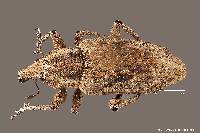Go to Encyclopedia of Life...
Henderson. 1940.
Length, 6.5 to 10.5 mm. Elongate oblong. Body black, elytra often partly or entirely piceous. Rather thickly clothed with scales which vary a great deal in color, ranging from light brown to dark brown, sometimes cupreous. Prothorax with narrow median and wider lateral vittae of paler scales. Humerus often with small spot of light scales continued from prothoracic vitta. There is an oblique dark mark centering on the fourth elytral interval at the anterior third, sometimes present only on that interval, other times longer and extending in some cases to include the second and sixth intervals. When this dark line is fully developed it extends posteriorly and toward the suture, reaching a little past the middle of the elytron ; it extends anteriorly toward the humerus. The oblique line is often more strongly developed on the lighter specimens, and on some very dark individuals may not be at all evident. There is a tendency for the scales between the oblique lines to be of a slightly darker color. Beak moderately stout, slightly longer than the prothorax. Upper surface with a distinct sharp median carina, lateral carinae usually moderately developed, not sharp. Antennae slender, second segment of funicle twice as long as first, third distinctly longer than fourth. Head slightly convex, densely, moderately punctate, the punctures bearing short, slender scales; frontal fovea usually deep and elongate. Prothorax wider than long, ocular lobes moderately developed; sides nearly parallel for three-fourths their length, then strongly rounded to apex; base slightly arcuate; disk quite densely punctate with moderately large, but very shallow punctures. Scutellum elongate, covered with slender scales. Elytra emarginate at base; humeri oblique; slides slightly narrowed to apical fourth, then strongly rounded to apex; striae fine, slightly impressed, the punctures very small, elongate, each bearing a tiny seta; intervals sometimes almost fiat, usually slightly convex, especially the odd ones ; intervals each with a row of distant punctures bearing setae which are more evident on the declivity; third and fifth intervals with punctures confused instead of in a single row; posterior calli prominent. Ventral surface with sides of all the sterna, except seventh abdominal, rather thickly clothed with large, round scales; middle of third and fourth abdominal sterna clothed with round scales; middle of fifth and sixth abdominal sterna and all of the seventh clothed only with elongate scales or setae. Male with tips of elytra conjointly rounded or very slightly subacuminate; third abdominal sternum concave at middle. Female with tip of each elytron prolonged into a short conical process; third abdominal sternum convex; seventh abdominal sternum with a slight depression in each posterior corner and with a short, rather deep median groove at the posterior part of the sclerite.














